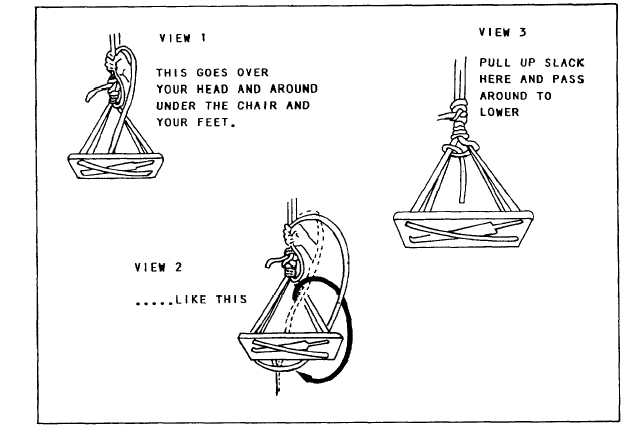| |
Figure 4-31.–Rigging for self-lowering.
jackets. Except for personnel in boats, personnel
working over the side must be equipped with a
parachute-type safety harness with safety lines tended
from the deck above.
All personnel should be instructed in all applicable
safety regulations before they are permitted to work
over the side of the ship on scaffolding, stages, or in
boatswain's chairs.
A competent petty officer must constantly
supervise personnel working on scaffolding, stages, and
in boatswain's chairs, and personnel must be assigned
to tend the safety lines.
When personnel are doing hot-work such as
welding or cutting while working over-the-side or aloft,
fiber lines could burn and cause a serious mishap. To
prevent this, replace all personnel safety lines and the
fiber lines on the staging and boatswain chairs with wire
rope. The Navy uses Corrosion Resistant Steel (CRES)
wire rope. However, since the Navy supply system does
not carry pre-assembled working or safety lines made
of CRES, you must make them yourself.
When doing hot-work over the side, replace the
nonadjustable, fiber-rope, working lanyard and the
fiber-rope safety lanyard (DYNA-BRAKE, if needed)
used with the safety harness with a 3/16-inch-diameter
CRES wire rope. The wire rope should be 6-feet long
(including the DYNA-BRAKE, if needed) with
double-locking snap hooks at each end. Secure both
hooks directly to the wire rope, using wire-rope thimbles
and swaging.
All tools, buckets, paint pots, and brushes used by
personnel working over the side of the ship should be
secured by lanyards to prevent their loss overboard or
injury to personnel below.
STAGE
The stage is a stout plank to the underside of which
two short wooden horns are attached athwartships,
either by nailing or bolting on, a foot or two from either
end. When the stage is rigged properly, all the weight
comes on the plank. The chief purpose of the horns is to
hold the plank off the side.
The gantlines on your stage may be rigged in one of
two ways. The first is by an eye splice in the end of the
4-39
|

